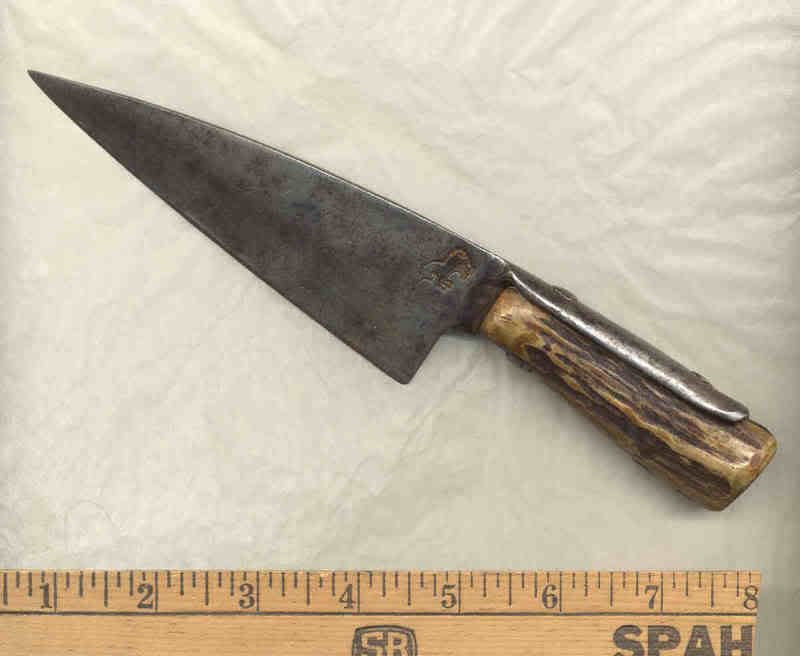This came up on one of the 18th Century living history forums, so I though it might be of interest here.
I made this knife earlier this year. I took one half of a sheep shear clipper, and turned it
into a knife with an antler handle. There are two iron pins (nails) holding the antler handle
to the blade. You do have to pick and choose carefully when looking for an old shears
to use. Of course, don't start with one that's been sharpened/worn back a lot. And
look for one that is all forged. Some are machine stamped from thinner steel. They tend
to have the top edge lapped back over to help stiffen the blade. The rest is to just cut off
the spring loop, shape up the handle material, drill a couple holes for pins/rivets, and
assemble it.

There are a number of knifes made from sheep shears in museums and private
collections. But the time period for them is the 1800's, and mostly the late 1800's. So
is is historically based. The originals tended to be made/modified by the Indians,
but some were "farm/ranch made" to meet an immediate need.
It does take a little getting used to the shape of the blade. It is flat on one side,
and tapered on the other - just like one half of a sissors. The better sheep shears to
start with have a smooth taper. Some of the later ones taper just a little across the
blade, and then have a steep bevel/taper in the last little bit to the cutting edge.
So check several carefully before you choose one to "play" with.
They do make a pretty cool knife. I'm a bit ... fond of it ... for some reason.
Yeah, that unicorn trade mark stamped into the blade is pretty cool also.
Just one of the little ... sharp objects ... I made earlier this year.
Mikey - yee ol' grumpy blacksmith out in the Hinterlands
I made this knife earlier this year. I took one half of a sheep shear clipper, and turned it
into a knife with an antler handle. There are two iron pins (nails) holding the antler handle
to the blade. You do have to pick and choose carefully when looking for an old shears
to use. Of course, don't start with one that's been sharpened/worn back a lot. And
look for one that is all forged. Some are machine stamped from thinner steel. They tend
to have the top edge lapped back over to help stiffen the blade. The rest is to just cut off
the spring loop, shape up the handle material, drill a couple holes for pins/rivets, and
assemble it.

There are a number of knifes made from sheep shears in museums and private
collections. But the time period for them is the 1800's, and mostly the late 1800's. So
is is historically based. The originals tended to be made/modified by the Indians,
but some were "farm/ranch made" to meet an immediate need.
It does take a little getting used to the shape of the blade. It is flat on one side,
and tapered on the other - just like one half of a sissors. The better sheep shears to
start with have a smooth taper. Some of the later ones taper just a little across the
blade, and then have a steep bevel/taper in the last little bit to the cutting edge.
So check several carefully before you choose one to "play" with.
They do make a pretty cool knife. I'm a bit ... fond of it ... for some reason.
Yeah, that unicorn trade mark stamped into the blade is pretty cool also.
Just one of the little ... sharp objects ... I made earlier this year.
Mikey - yee ol' grumpy blacksmith out in the Hinterlands
